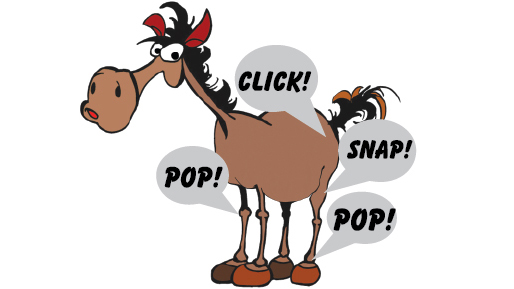It’s a cold day, so I bring my horse, Cody, into the indoor arena to run around for a bit and stretch his legs before I bring out the tack. As he starts to trot, I hear surprisingly loud “pop, pop” sounds that seem to be coming from his knees. Cody doesn’t seem bothered by these joint noises – he gives a few kicks and canters in large circles before coming back to the arena gate. He seems fine, but to me those sounds were extremely alarming. Should I be worried?
Probably not, according to Dr. Kathleen MacMillan of the University of Prince Edward Island’s Equine Ambulatory Service, who says that cracking or popping sounds from the hips, knees, fetlocks, hocks, and stifles are usually caused by gas pockets moving around in the joints (similar to when we crack our knuckles). As she explains, there is always some gas dissolved in the synovial fluid that surrounds the joints and as the joint moves, you may hear popping sounds. Another possible cause may be ligaments that are a little bit lax and as they slide across the horse’s joints, they may also cause a popping sound. “These noises don’t mean there is anything wrong with the horse, but people do panic at times when they hear them,” says MacMillan. “As long as the horse is sound, they are usually not a concern.” Joint noises may be more common in older horses, because they lose a little fitness and strength, creating more laxity in the ligaments and therefore more popping sounds.
When do joint noises become a concern? “If the horse is lame and has damage to the cartilage, you may hear a bone-on-bone grinding sound as the horse moves,” says MacMillan. “I have only heard it a few times myself and it is not a very nice sound! This horse would be significantly lame and almost unable to bear weight at all.” If a horse has previously not had any noises from his joints and suddenly starts making them, MacMillan says it is not likely to be a problem, but she would recommend monitoring the horse closely to ensure there is no lameness developing.
Joint noises can, in fact, have a positive side. “I think that once a horse owner hears joint noises, he becomes more aware of the horse’s movement – and that’s good. If you know your horse better, you are more likely to notice if something is changing in the way he moves, even if the changes are small at first.”
Protecting your horse’s joints, noisy or not, is important. Dr. Judith Koenig of the Ontario Veterinary College says it is important to warm your horse up gradually before any riding session, and especially before strenuous activity. As well, she recommends using joint supplements, but warns that it can be a tricky area to wade into. “There are many supplements out there, and research studies have found that many of them do not actually contain what was promised on the label,” says Koenig. (For example, a 2006 study by Canadian veterinarian and researcher Stacy Oke found that more than one-third of supplements containing glucosamine had significantly lower amounts than the label indicated, and in fact had levels so low that they were not therapeutic.)
Koenig suggests horse owners who are concerned about this issue talk to their veterinarians about the systemic supplements administered to the horse by injection. “This can be especially helpful for an older horse who has worked hard all his life,” Koenig adds. “While these injected supplements seem more expensive at first, if you compare the cost to oral supplements added to the feed every day for a whole year, the cost may be less. Plus you can be confident that the horse is getting what he is supposed to be getting.” MacMillan adds that some joint supplements have been studied more than others, and your veterinarian can point out which ones have the weight of research behind them.
Even more important than supplements, says Koenig, is ensuring that you have a good farrier and that your horse’s feet and shoes are well maintained. “Often, horses have shoes that are too small, and that is just like it would be for us to run around all day in shoes that are too small.” MacMillan adds that having the hoof trimmed so that it is level and the shoe is balanced means that undue stress is not put on any part of the leg or joints.
“Joint problems are more common than many horse owners realize,” says MacMillan. “The owners think the horse is getting a little stiff as he gets older, or that the problem is caused by colder weather. But it is prudent to have the veterinarian look at your horse if he is showing some of these problems, especially if it is more in one leg than another. This may be something that can be easily treated.”

